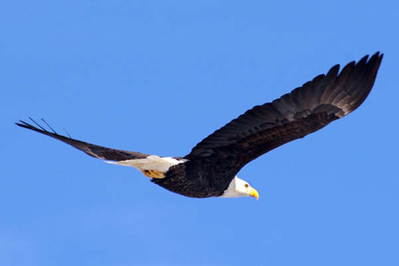
A Throng of Bird Species
By Terry Sprague
Terry Sprague is regarded as Prince Edward County's primary naturalist. In this excerpt from his contribution to Wind, Water, Barley & Wine, he tells about the phenomenal number of bird species found in the county.
Perhaps no aspect of our wildlife is more dynamic than birds. With interest in birding escalating each year, consequently there are more knowledgeable birders in the field today than there were a century ago, documenting changes as they occur. Lester Snyder’s faunal investigation of Prince Edward County in 1930 documented the occurrence of 225 species of birds. Today, the total is 351 species. Even with Snyder admitting that a "dozen or so species” may have been overlooked during his faunal investigation, to see the county’s bird checklist grow by more than 100 species in only eight decades speaks for the ability of birds to move out of their normal range and appear in Prince Edward County. Many have become regular visitors, with a good number having established themselves as breeding birds.
 One example of avian change has been the northern cardinal.
According to Snyder’s report, the cardinal was not found during the 1930
survey. During this time, the cardinal was experiencing a northward expansion
of its range and it was only eight years later when the first individual turned
up at a feeding station in the county. Another showed up the same year at
Consecon. Prior to that first sighting, the cardinal made its Ontario debut as
a breeding bird at Point Pelee in 1901, Toronto in 1922, and in just 16 years
had managed to make its first appearance in Prince Edward County. As recently as the early 1960s breeding was
practically unheard of in the county, but today the cardinal is considered a
common permanent resident. Other species of southern affinities that are
becoming established here as breeding birds include the orchard oriole,
northern mockingbird, red-bellied woodpecker and blue-gray gnatcatcher. Others,
like the Kentucky warbler, chuck-will’s widow, white-eyed vireo, and summer
tanager that are observed occasionally in spring are presumed to be migratory
"overshoots”. Others that appear only sporadically like the 1901 anhinga of
tropical and sub-tropical United States, varied thrush from the coastal regions
of western North America, and the fork-tailed flycatcher of Mexico and South
America, fail to share their stories of travel with us, their appearances
adding to the thrill of the unexpected.
One example of avian change has been the northern cardinal.
According to Snyder’s report, the cardinal was not found during the 1930
survey. During this time, the cardinal was experiencing a northward expansion
of its range and it was only eight years later when the first individual turned
up at a feeding station in the county. Another showed up the same year at
Consecon. Prior to that first sighting, the cardinal made its Ontario debut as
a breeding bird at Point Pelee in 1901, Toronto in 1922, and in just 16 years
had managed to make its first appearance in Prince Edward County. As recently as the early 1960s breeding was
practically unheard of in the county, but today the cardinal is considered a
common permanent resident. Other species of southern affinities that are
becoming established here as breeding birds include the orchard oriole,
northern mockingbird, red-bellied woodpecker and blue-gray gnatcatcher. Others,
like the Kentucky warbler, chuck-will’s widow, white-eyed vireo, and summer
tanager that are observed occasionally in spring are presumed to be migratory
"overshoots”. Others that appear only sporadically like the 1901 anhinga of
tropical and sub-tropical United States, varied thrush from the coastal regions
of western North America, and the fork-tailed flycatcher of Mexico and South
America, fail to share their stories of travel with us, their appearances
adding to the thrill of the unexpected.
Illustration: A bald eagle soars over Prince Edward County. Photo by Susan Shipman
Much, much more about Prince Edward County nature will be available in the upcoming book, Wind, Water, Barley & Wine, including a list of all 351 bird species occurrences in the county.
